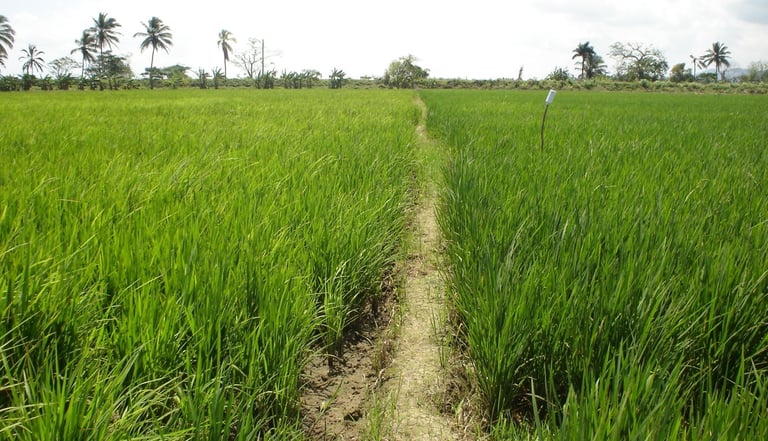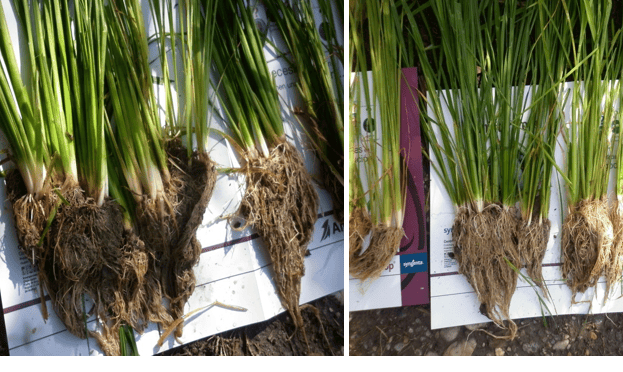Benefits
Nutrient Efficiency
AgriMatrix helps create a balanced soil chemical environment, supporting efficient nutrient use. Its mineral composition can increase the cation exchange capacity (CEC) in the root zone and help maintain a more favorable pH. By conditioning the soil solution, AgriMatrix may reduce nutrient loss and help growers use applied fertilizers more effectively.
Silicon and magnesium are often overlooked but play silent roles in nutrient dynamics. When they’re present, plants can do more with less.
Helps maintain soil chemistry that supports efficient fertilizer use
May aid in phosphorus and potassium availability by improving soil chemical balance
Supports conditions for micronutrient availability (Zn, Fe, Mn)
May help reduce nutrient leaching in sandy or acidic soils
Promotes more consistent performance from applied fertilizers
Helps reduce variability in nutrient availability across the field


Root System Support
Healthy roots depend on a stable soil environment. MagSil contains magnesium and silicon in a mineral form that helps moderate undesirable soil chemistry, creating conditions that support strong root development.
A better root system gives your crop more access to nutrients, stability in dry periods, and the ability to outcompete weeds.
Supports a more favorable root zone by balancing soil pH and chemistry
Encourages robust root systems under variable soil conditions
Helps maintain anchoring and stability in challenging soils
Supports early vigor where soil acidity or chemical imbalance might limit rooting


Microbial Enhancement
AgriMatrix helps stabilize soil chemistry and maintain a balanced mineral environment, which can favor a healthy soil biological community.
We help create a more structured, mineral-rich environment — conditions that many growers say seem to wake up their biology.
May help maintain conditions that support beneficial microbial activity
Can assist with organic matter cycling by improving soil chemical balance
Supports soil aggregation and respiration through improved pH buffering


Soil pH Buffering & Acidity Moderation
Acidic soils can lock up nutrients and reduce soil biological activity. MagSil products contains natural minerals that help buffer soil acidity over time supporting a more balanced soil environment.
AgriMatrix can help buffer pH over time, particularly in low pH soils prone to locking up nutrients. Farmers say their soils “feel more forgiving” and less reactive to acidic shocks (from fertilizers or rainfall).
Helps moderate acidic soils gradually
Supports nutrient availability in soils impacted by acidity
Helps maintain balanced cation ratios for better soil structure and function


Stress Resilience
Maintaining a balanced soil environment can help crops cope better with challenging conditions. By improving pH stability and supporting a healthy root zone, AgriMatrix helps soils perform more reliably under drought, salinity, and temperature extremes.
Heat waves. Drought. Heavy rains. Poor germination.
Farming under stress is the new normal — and AgriMatrix has become part of how some growers are adapting. Many say crops appear to hold on longer during dry spells, or emerge more evenly despite variable conditions.
The product doesn’t prevent stress — but it may help your soil and roots be better prepared for it.
Supports soil conditions that help plants use water efficiently
Helps maintain root function in challenging soils
May reduce transplant or establishment stress by stabilizing soil chemistry


Innovative Solutions
Enhancing soil health and plant vitality for sustainable agriculture.


Root Strengthening
Boosting root systems for improved crop resilience and yield.


Soil Structure
Enhancing soil structure for better nutrient efficiency and growth.




Nutrient Efficiency
Maximizing nutrient uptake for healthier, thriving plants.
Environmental Resilience
Supporting crops to withstand challenging environmental conditions effectively.
→
→
→
→
MagSil LLC
Empowering growers with natural soil amendment solutions
info@magsil.us
© 2025. All rights reserved.
